
Spatial Analysis: Data Processing And Use Cases
The first attempts of spatial data analysis date back to the 1960s and belong to Canada. The earliest objective for GIS applications was the systematization of the country’s natural resources. Spatial analysis in GIS has expanded worldwide ever since. It is difficult to imagine a single entrepreneur or a superindustry that does not benefit from georeferencing in this or that way.
Spatial analysis allows determining if the selected area is suitable for particular business activities, detecting changes, identifying tendencies, assessing risks, outlining possible outcomes, and preventing losses.
Up-to-date tools and spatial analysis techniques provide more accurate analytics than decades ago.
What Is Spatial Analysis?
Geospatial analysis is a process of GIS data interpretation, exploration and modeling, from acquisition to understanding results. The retrieved information is computer-processed with spatial analysis software and varies depending on the number of tasks and their complexity. The simplest one is visualization, while a more detailed approach suggests comprehensive analytics with specific tools to elaborate actionable insights.
Examples of spatial analysis include measuring distances and shapes, setting routes and tracking transportations, establishing correlations between objects, events, and places via referring their locations to geographical positions (both live and historical).
Typically, spatial analysis consists of five key stages: understanding your goal, preparing data, choosing suitable tools and techniques, performing the research, and estimating results.
So, first of all, it is important to figure out what you are interested to know. The next will be to choose corresponding spatial analysis methods for data manipulation and interpretation. Knowing exactly what you want to get, you will be able to tailor the research techniques to your needs. Once you determine, you start the next stage of spatial analysis – data processing and interpretation. Last, you estimate the results to define if you achieved your goal or not.
Spatial Analysis In GIS: Set Up Your Objectives
The peculiar feature of GIS spatial analysis and modeling is its flexibility. You can match as many layers as you like and get different results accordingly.

The scope of applications covers numerous branches including agriculture, forestry, marine sciences, oil and gas, mining, demography, economy, to mention a few. In particular, spatial analysis for agriculture defines vegetation density, degree of soil moisture and soil temperature, crop state, etc. It enables farmers to allocate resources in the most efficient way (like sparing distribution of chemicals). In forestry, spatial data analytics helps to spot deforestation and predict fires by critical temperatures.
Relying on spatial analysis results, oceanologists identify oil spills, and demographists can decide if educational and healthcare institutions are sufficient to meet the population needs of the studied region.
With spatial data analysis in GIS, logistic specialists build up the fastest or safest routes, retailers see the most advantaged store location, and rescue teams allocate aid to the most affected areas.
For complex questions in spatial analysis, it is important to split them into more specific ones. Answering each of them, you will reach a goal step by step.
For example, a chain store owner may be interested in: “What is the best location for a new shop in LA?” This query can comprise several minor ones:
- How many competitors provide the same services in LA?
- What districts of LA the target customers live in?
- How big is this population in the questioned areas?
- Are the competitors’ shops distributed evenly?
- Are there any areas with faraway stores that provide the same services?
- What is the mean income across LA districts where the potential customers live?
Spatial Data Analysis: What You Need For A Proper Start
To carry out successful spatial analytics research, it is important to prepare everything in advance. So, make sure you have all the required data for examination and refine the content to the state you need. Pre-processing in spatial analysis may generally require several preliminary steps like geometric and spectral correction, radiometric correction of atmospheric effects, missing pixel restoration, contrasting, and filtration.
Geometric Correction
Geometric rectification for spatial data analysis suggests geographic reference of images and improvement of geometric discrepancies due to several reasons that match differently for different satellite imagery types.
The Earth’s surface is not even. Due to its spherical shape, the most accurate captures are those made at nadir (the central scan line). Correspondingly, a farther position from nadir involves greater distortions.
The relief curves impact image precision as well. However, the great distance between the satellite’s orbit and Earth makes the effect smoother, so in spatial analyses, it is usually ignored. The exceptions are high-elevation areas, e.g., mountainous regions.
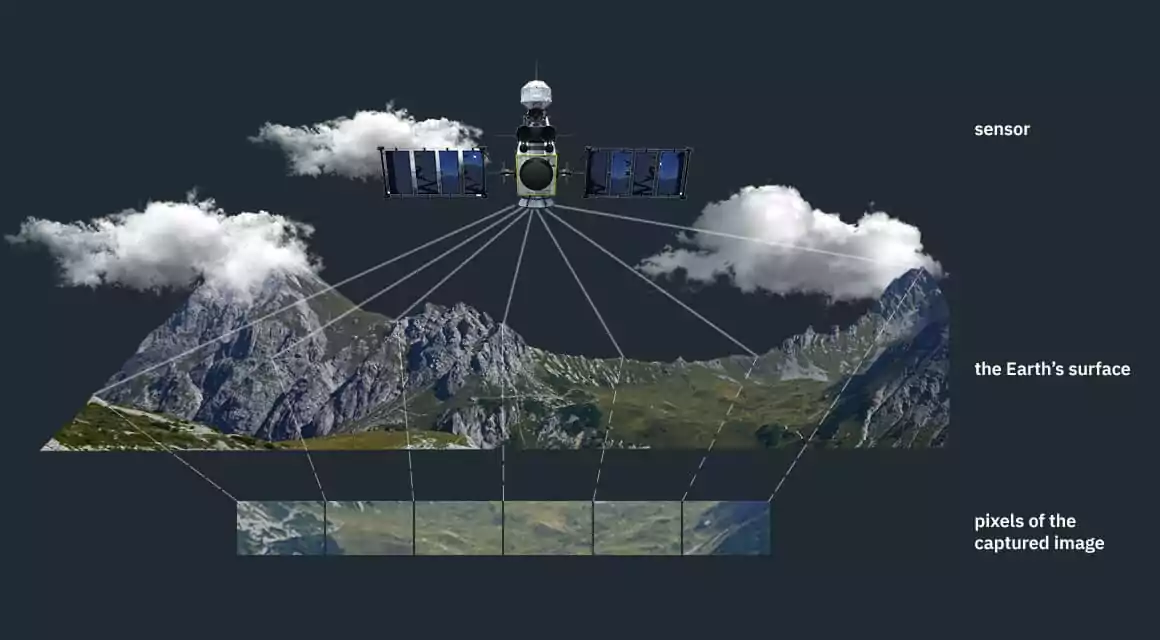
Another significant aspect in spatial analysis is that our planet is constantly moving around its orbit and around the Sun. It shifts its position by 0.25 every single minute, and this rotation affects the focus. Besides, the satellite is orbiting Earth in its turn, and revolving the image quality as well.
Spectral Correction
Any real-time satellite imagery initially has the so-called “raw” brightness values (digital numbers). This data format does not allow a proper comparison of images retrieved from various sources. For this reason, spectral (or radiometric) correction in spatial analysis is applied to adjust digital numbers to physically meaningful units, i.e. actual surface reflectance or emittance values.
Radiometric Atmospheric Correction
Image quality also depends on atmospheric conditions that weaken the signal both from the sensor and from the target. Scattering due to atmospheric aerosols (dust, mist, fog, carbon dioxide, methane, etc) alongside radiation absorption and cloud cover are the major factors affecting the pixel brightness and thus requiring additional adjustment.
There exist various methods to reduce atmospheric effects in spatial analysis, e.g., image-based calculations or modeling. Mathematical techniques imply modeling different atmospheric conditions depending on the season, weather conditions, aerosols, etc.
Besides, the optical properties of water bodies are similar to the ones of absolutely black objects in the red and infrared bands. Knowing it, a spatial analysis expert can easily distinguish clouds and haze against the marine background.
Missing Pixels Restoration
Some information necessary for spatial analysis may be missing due to system errors during data acquisition or transmission, contrails , etc. The most common reconstruction method of dropped lines for spatial data analysis suggests taking pixels from neighboring lines or making the average of the two. Even the replacement implies certain errors, it facilitates further image interpretation.
Image Contrast Enhancement
The contrast in photography is the difference in minimum and maximum luminance, or brightness and color saturation, which allows distinguishing the object and its contours against the background. Low contrast is a typical issue to fix. In particular, contours for spatial analysis and modeling can be better outlined with visual imagery decoding.
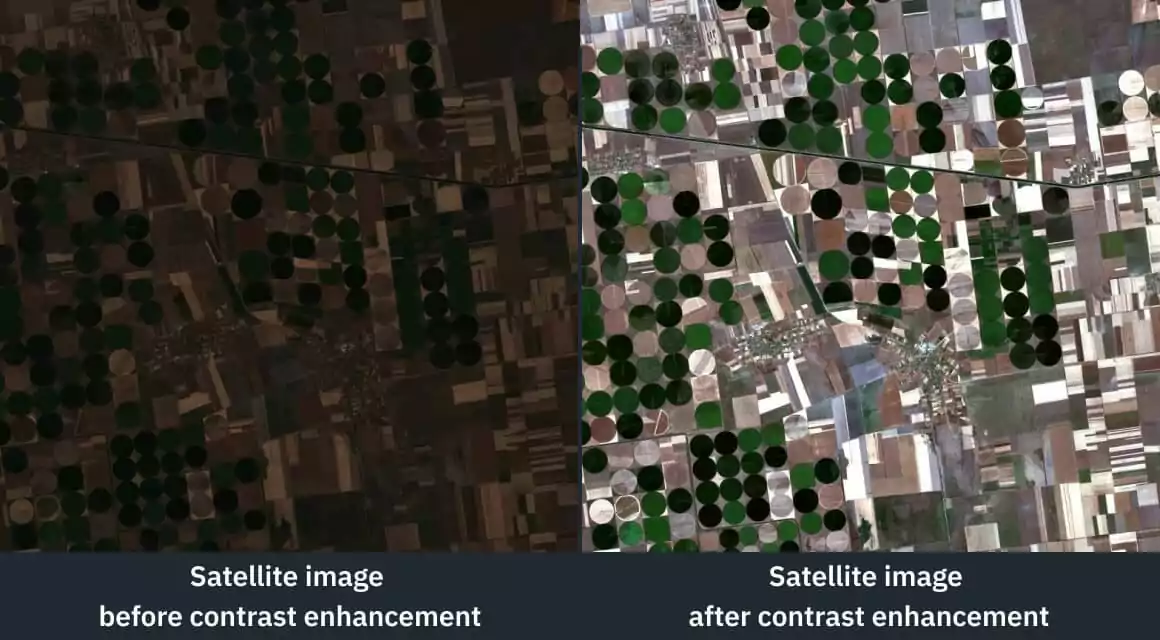
Digital image processing for contrast enhancement in spatial analysis involves the following techniques of histogram modifications:
- Linear expansion generates new values to the input image pixels extending the value range.
- Normalization in spatial data analysis in GIS expands the most intensive histogram area.
- Equalization corrects pixel brightness to make their number equal or similar at each brightness level.
Image Filtering
Filtering in spatial data analysis outlines required objects and reduces noises by means of sliding window modifications with recalculations of existing pixel values and assigning new ones. The new values are established mathematical functions from neighboring pixels. Formula coefficients depend on decoding tasks. The window may comprise 3×3 or 5×5 pixels and moves by one pixel until the whole image is covered.
Apart from sharpening and noise removal, the filtering technique is applied for smoothing and contour edging.
EOSDA LandViewer
Search for satellite images in one of the biggest online catalogs equipped with custom band combinations and compatible with most GIS tools.
Equip Yourself With Suitable Spatial Analysis Techniques
A significant advantage of digital imagery is the possibility of its computer processing, which can be carried out not only to prepare data but provide geospatial analysis proper. Ideally, the whole analytical process is automated and completed by a machine. Yet, it rarely happens practically. In most cases, specific tools facilitate a scientist’s research.
Color Transformations
A single channel of multispectral imagery is displayed in gray. It becomes colorful only in the combination of three channels, including red, green, and blue (the so-called RGB model). In spatial data analysis, the image can be presented in natural or false colors, depending on whether RGB channels coincide or are replaced by other bands.
Prevailing tones are determined by channel brightness. For example, high pixel values for the R channel will give mostly reddish hues. Correspondingly, dominating brightness of the G channel will result in shades of green.
While it is easier to identify the objects in natural colors, false-color images in geospatial data analysis allow distinguishing between them and outlining their contours.
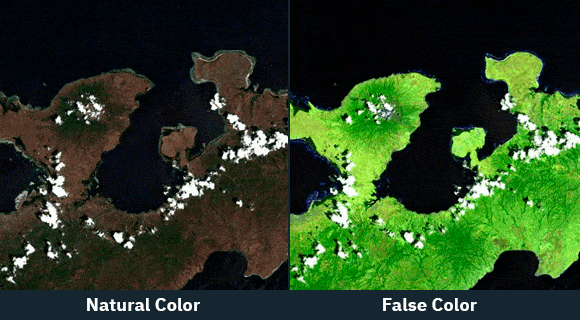
Indexed Images
The method of indexed images employs recalculating brightness values for each pixel in different channels with established mathematical operations. This way, pixels are represented for analysis not in their absolute brightness but are assigned new indexed values according to the colormap matrix. Indexation highlights the target objects and simplifies the research.
Principal Components Analysis
The technique of principal components analysis correlates multispectral data, which implies that higher brightness in one band involves higher brightness in the other bands as well.
This method of geospatial data analysis allows the following manipulations:
- creating an output image with three principal components among three and more bands ignoring minor components, and thus eliminating noises;
- enhancing vaguely distinguished objects on single-component spatial imagery;
- comparing spatial image series captured within different time frameworks to understand the dynamics and changes;
- reducing the spatial data size with minimum information lost.
Spectral Unmixing
The given method of pre-processing in spatial analysis applies to define targets much smaller than the pixel size on images with multiple objects. In this case, an analyst compares the retrieved data with existing pure spectrum registries understanding quantitative discrepancies between a pure spectrum and mixes for each pixel spectrum. The obtained image will allow distinguishing the main element by its coloring.
Classifications
Classification in spatial analysis is computer imagery decoding or automated pixel categorizing into specific classes to differentiate the objects (hence the technique name derives). Classification can be performed with and without training data.
Classification With Training Data
This classification type in geospatial analysis relies on comparing pixel brightness with certain samples. Analyzing correspondences, the operator can refer particular objects to the most suitable classes (e.g., in urban imagery there can be buildings, roads, vegetation). This method works if the scenery components are known, they are less than thirty in number and easily distinguished on the spatial image.
The most widely-used spatial analysis techniques of this classification type include:
- method of spectral angle in spatial analytics applies for the classification of objects with similar brightness values;
- parallelepiped classification is used in spatial analytics when brightness scales do not intersect;
- minimum distance estimation in spatial analysis works when brightness scales intersect;
- Mahalanobis distance provides more accurate measurements in multivariate space, compared to the previous technique;
- maximum likelihood estimation aligns the object to a group based on maximum probability calculations. The method is employed in spatial data analysis when brightness scales overlap and have a complicated shape;
- binary splitting divides all spatial image pixels into two groups.
Classification Without Training Data
These algorithms automatically separate pixels via statistical brightness distribution and are applicable when objects are not identified or exceed thirty in number. Classifications without training data can be used in spatial analysis prior to ones with training.
Examples of the most typical unsupervised categorizations for spatial data analysis include ISODATA and K-Means clustering:
- ISODATA is the acronym for the Iterative Self-Organizing Data Analysis Technique. It relies on referring pixels with the closest brightness values in the spectral feature space.
- K-Means clustering in spatial analysis is similar to ISODATA but requires certain basic mean values to categorize the objects.
Start Up The Analysis Process
Performing the spatial analysis proper is the next stage after shaping the problem, pre-processing preparations, and choosing the most suitable techniques. Once the preliminary steps are completed, a spatial data analyst focuses on obtaining qualitative and quantitative results.
Consider The Output Information
Data retrieval should be followed by detailed research if the objectives of spatial analytics were achieved or not and how the results can give answers to similar questions in the area of study and other industries.
This stage of spatial data analysis also suggests consideration of practical use and relevance of acquired information by consulting credible sources. For example, when elaborating a crop map of the U.S. with satellite data, the results should correspond to the official governmental statistics.
Another issue is to figure out if the information obtained with spatial analysis can be validated, i.e. how accurate it is. The last but not the least point is to assess the data quality by its quantity, deciding if the results are missing, sufficient, excessive, etc.
A good point of spatial analysis is visualization for better understanding like static and interactive charts, graphs, diagrams, tables, or maps.
How is Spatial Analysis Performed In EOSDA Products?
Geospatial data analysis has plenty of applications in various industries, and agriculture, forestry, and ecology in particular. It allows monitoring the current state and boosting profit on the one hand, and raising environmental awareness and addressing natural calamities on the other. Furthermore, spatial imagery enables experts to inspect hard-to-reach areas without being physically present there, model situations, and mitigate negative consequences.
The following use cases illustrate spatial analysis applications by EOSDA products (EOSDA LandViewer and EOSDA Crop Monitoring) and their actionable insights.
Forest Fires In Colorado
Forest fires in late 2020 turned into a real catastrophe. They ran even a worse scenario due to droughts, hot weather, and high mountainous positions. While usually snow helps manage the issue, the fires rapidly expanded this time (by six times per day).
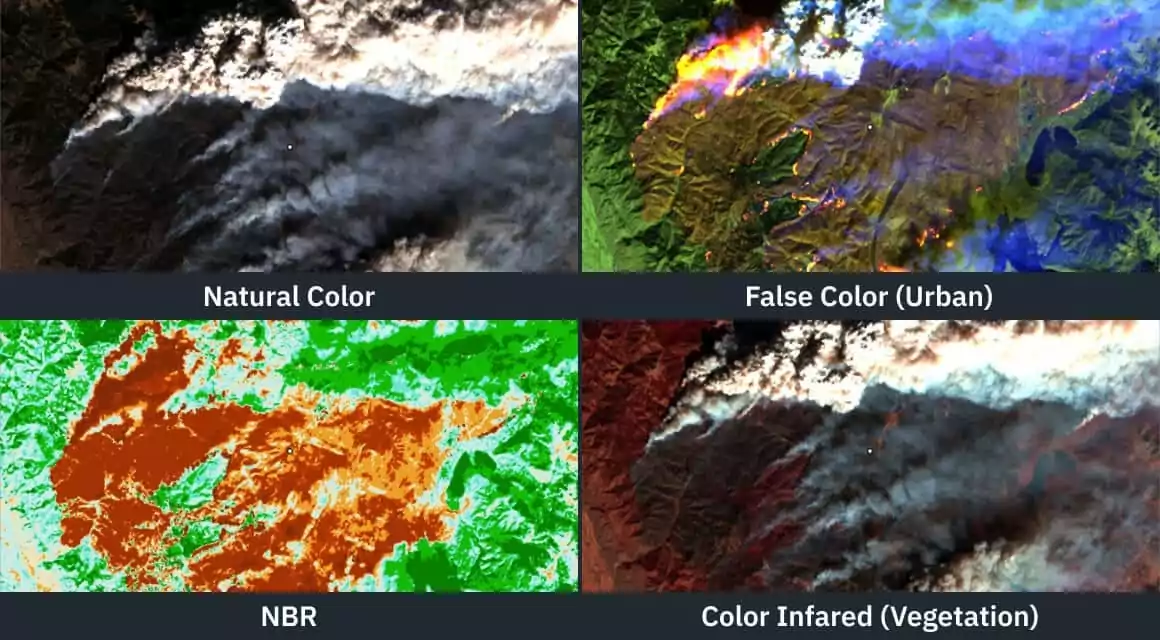
The case of the forest fires in Colorado is based on geospatial analysis that includes multispectral data from the optical satellite Landsat-8 and the following band combinations:
- False color (Urban) with SWIR2, SWIR1, Red is relatively insusceptible to atmospheric effects, going through particles dispersed in the atmosphere.
- Natural color composites for spatial analytics depict the target as it is perceived by a human eye.
- Color IR (Vegetation) is typically used in spatial analysis to distinguish between bare soils and healthy/scarce vegetation cover. Broadleaf and/or healthier plants give a more reddish picture, while low-density areas are highlighted in less intensive reds.
- The Standardized Burning Index NBR in geospatial analysis enables to assess burnt areas smoothing atmospheric influence.
Floods In Colombia
In late October, 2020 six rivers flooded seven municipalities in Magdalena, Colombia, destroying thousands of houses. The affected municipalities include Aracataca, Algarrobo, El Reten, Fundación, Bananera Zone, Pueblo Viejo, and Cienaga.
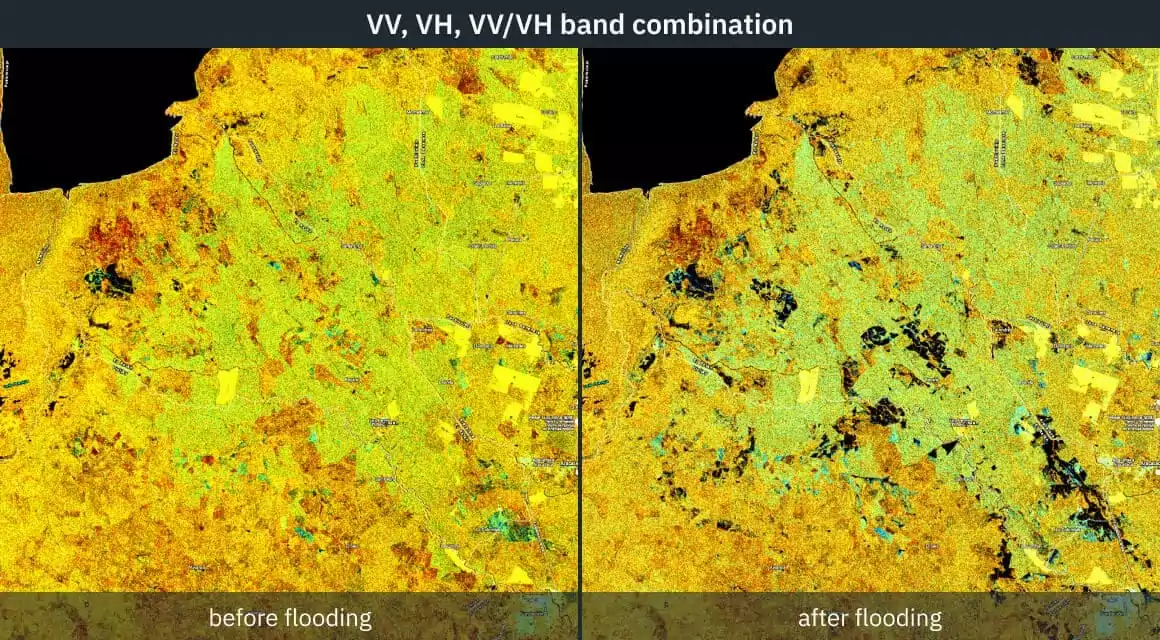
The case of the floods in Colombia relies on spatial analysis that incorporates data retrieved from the radar satellite Sentinel-1 and applies the band combinations of VV, VH, VV/VH composites. These composites are efficient to monitor water bodies, moisturized agricultural territories, vegetation, as well as bare soils and urban areas.
Tropical Cyclone Gati In Somalia
Gati has been the strongest tropical storm near coastal Somalia and the first landfall cyclone in the Arabian Sea area since 1970 (when the records were initiated).
The cyclone outraged on November 21-24, 2020 with a landfall in Somali on November 22. The catastrophe was classified as “very severe” by the India Meteorological Department and assigned “category 3” according to the Saffir-Simpson Hurricane and Wind Scale. The fatalities statistics report at least eight persons perished, with dozens missing.
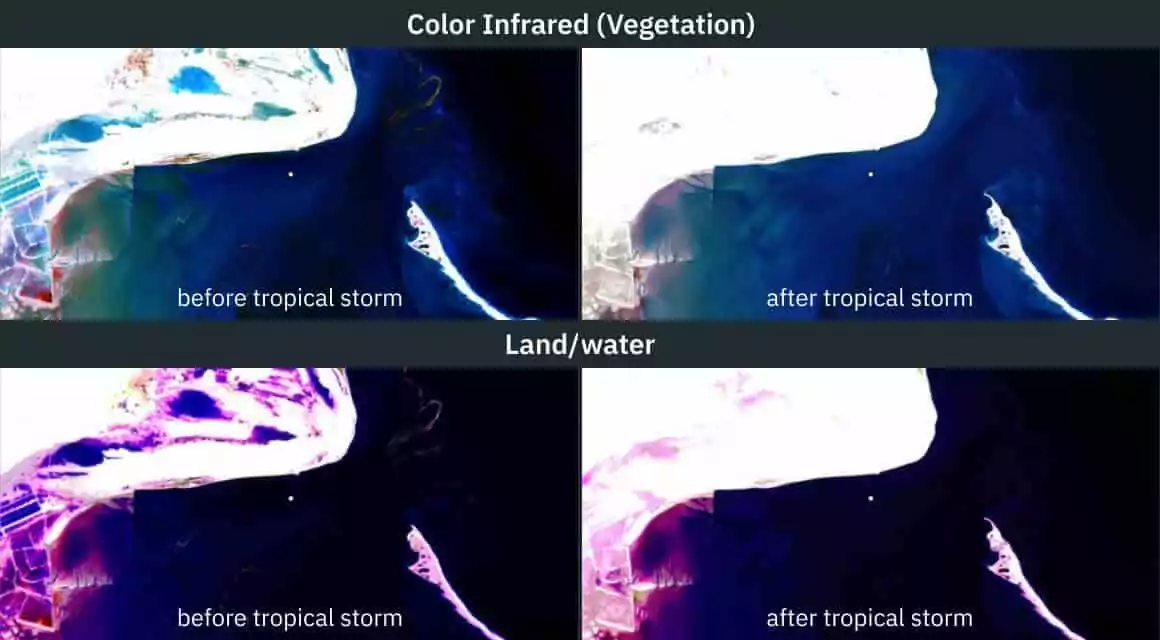
For a solution to monitor the cyclone and assess its consequences, EOSDA performed a spatial analysis of data acquired by the optical satellite Sentinel-2. To do so, it employed standard color infrared channels for vegetation and the NIR, MIR and IR land/water composites to identify water objects on land and mark the borderlines between land and water.
Rice Field Damaged By Hail
In agriculture, spatial analysis is used for different purposes, including identification of various types of damage by natural anomalies or routine farming activities. The example below shows how the rice field has been damaged by hail. EOSDA Crop Monitoring software reveals the most visible changes via NDVI and ReCI indices.
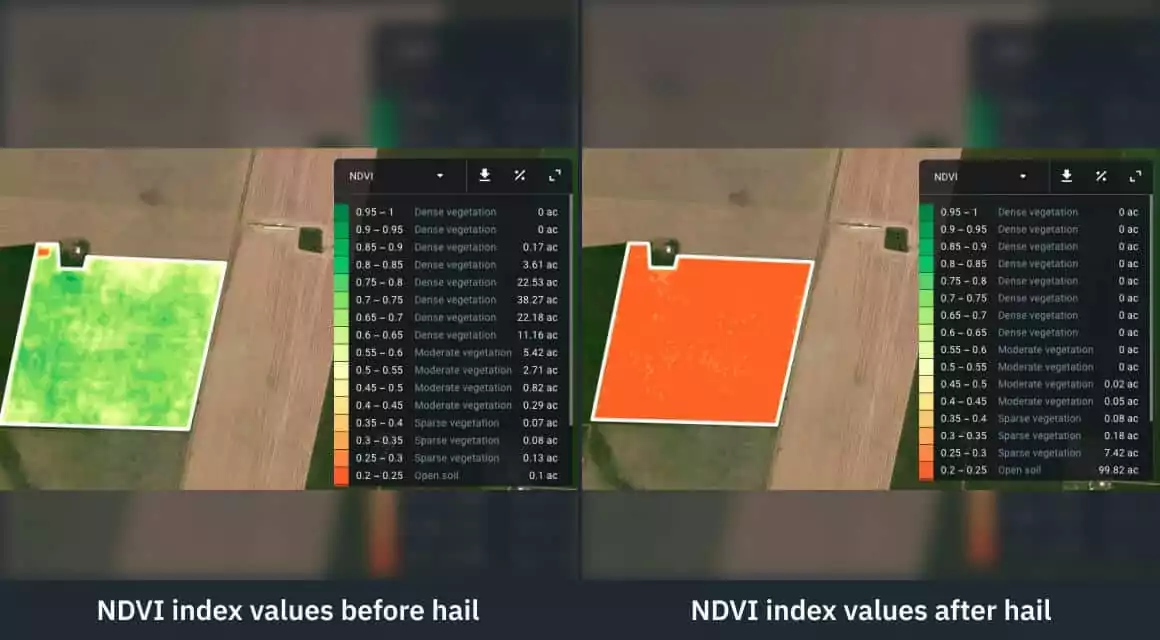
Benefits Of Spatial Analysis
Spatial analysis in GIS facilitates decision making in many spheres from minor routine business issues to global disaster response. The georeferencing technology not only recognizes the coordinates but states the time as well, which allows tracing changes and understanding trends.
While satellites capture remote and hard-to-reach places, spatial analysis software and techniques allow data handling with accuracy and speed that a human analyst would never compete. Computerized spatial data analytics enables nearly instant processing of a huge data bulk.
The obtained results of GIS geospatial analysis highlight the situation from multiple angles:
- help understand the current state of things;
- trace tendencies and react correspondingly;
- develop business strategies analyzing data referred to space and time.
Visualizations in spatial data analysis simplify information perception by rearranging, categorizing, modeling, sorting, and presenting big data in easy-to-remember patterns and enhancing important details.
Thus, spatial analysis provides situation awareness and actionable insights for present and future in any question where geographical position matters.
About the author:
Petro Kogut has a PhD in Physics and Mathematics and is the author of multiple scientific publications. He is the Soros Associated Professor as well as the head of the department of differential equations in the Oles Honchar Dnipro National University and has received a number of grants, prizes, honorary decorations, medals, and other awards. Prof. Dr. Petro Kogut is a science advisor for EOSDA.
Recent articles
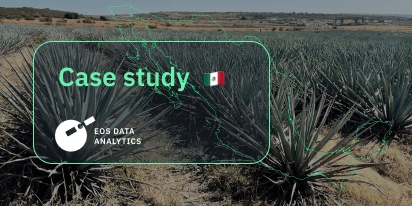
Digital Tools Improve Soil Health And Yields In Mexico
EOSDA and ITTA supported a Guanajuato farm with contour-line planning, monitoring tools, and practical guidance to reduce soil erosion and improve yields in the long run.

Analyze 2025 & Plan Your Best Year Yet: LandViewer Christmas Offer
It’s the most wonderful time of the year! The Christmas holidays are here, and so is your chance to analyze 2025 and plan a prosperous 2026 with more affordable Pro plans in LandViewer.

EOSDA Models Climate Change Impact On Sugarcane Yields
EOSDA modeled future temperature, rainfall, and other climate impacts on Veracruz sugarcane. The results help growers plan long-term adaptation strategies, including timing, varieties, and irrigation.